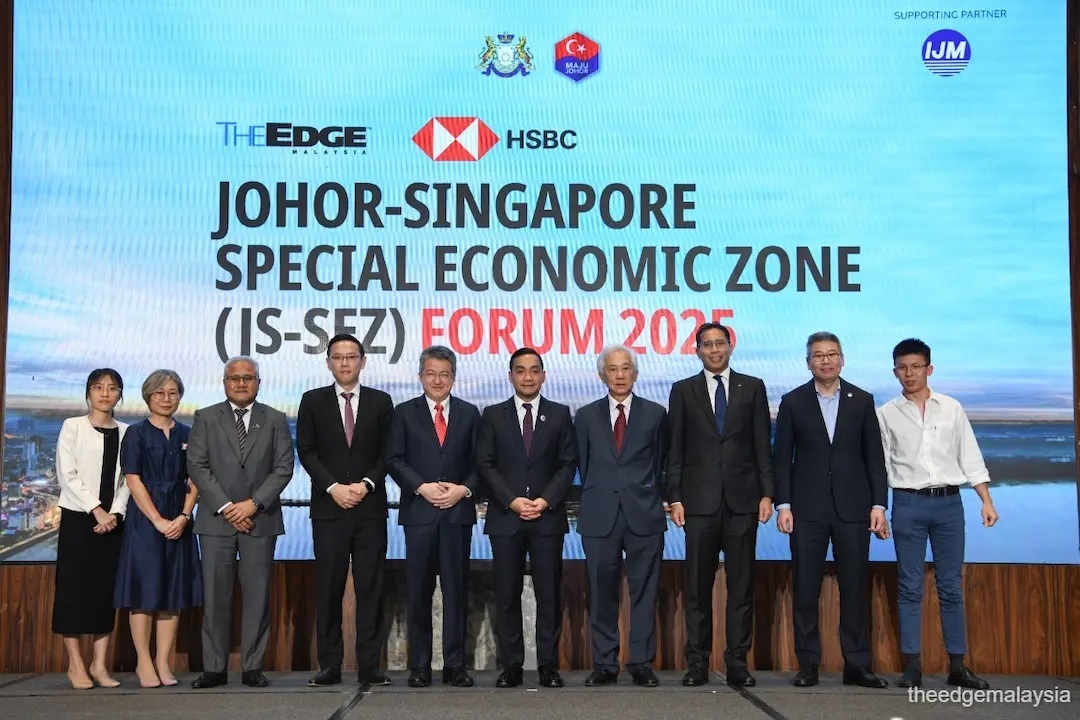
- The JS-SEZ has nine flagship areas and promoted sectors including electrical and electronics, petrochemical and oleochemical, food and agro-processing, logistics, tourism, healthcare, financial and business services, and creative and education.
JOHOR BAHRU (June 23): Johor, a rapidly growing economic hub in Malaysia, aims to attract up to RM100 billion in investments by the end of 2025.
According to Johor Menteri Besar Datuk Onn Hafiz Ghazi, the state has already secured RM30.1 billion in approved investments in the first quarter, and now needs about RM70 billion more in the remaining nine months to reach its target.
“We are confident that Johor is poised to reach between RM60 billion and RM100 billion by the end of this year, surpassing our RM48.5 billion last year,” Onn Hafiz said in his keynote at The Edge-HSBC JS-SEZ Forum 2025 on Monday.
“This achievement puts Johor firmly on the map as a leading investment destination in the region,” he added.
The forum was attended by over 1,300 attendees, both in-person at the DoubleTree by Hilton hotel and virtually via Zoom, and brought together speakers from both Malaysia and Singapore to discuss the present and future of the Johor-Singapore Special Economic Zone (JS-SEZ).
The bullish outlook comes on the back of growing momentum from the JS-SEZ initiative—which, since its formal agreement in January between Prime Minister Datuk Seri Anwar Ibrahim and Singapore’s Prime Minister Lawrence Wong, has begun drawing both domestic and international investor attention.
The JS-SEZ has nine flagship areas and promoted sectors including electrical and electronics, petrochemical and oleochemical, food and agro-processing, logistics, tourism, healthcare, financial and business services, and creative and education.
Onn Hafiz aims to transform the state into Malaysia’s most developed by 2030, with a targeted RM260 billion in gross domestic product, 20,000 high-income jobs, and 50 catalytic projects spanning 11 high-impact sectors.
The state launched the Invest Malaysia Facilitation Centre Johor (IMFC-J) in February—a one-stop centre managed by the Iskandar Regional Development Authority (Irda), Invest Johor and the Malaysian Investment Development Authority (Mida)—designed to streamline bureaucratic processes and accelerate investor timelines.
In just five months, the IMFC-J has recorded 439 inquiries, identified 57 potential investments worth RM26.2 billion, and secured six committed investments totalling RM16.7 billion. Processing times have been cut from three months to as little as one, positioning Johor as an efficiency-driven hub for business.
“We are not waiting for the JS-SEZ master plan to be completed,” Onn Hafiz said. “We are already working tirelessly to address investor demands and accelerate facilitation.”
In his opening remarks, publisher and group CEO of The Edge Media Group, Datuk Ho Kay Tat, called the JS-SEZ one of the bright spots in Malaysia, as he highlighted the progress made on the Rapid Transit System (RTS) Link, designed to better facilitate the flow of people for both Johor and Singapore.
“Without a doubt, the JS-SEZ is an ambitious project, and while many steps have been taken, the path ahead is still a long one,” said Ho.
The JS-SEZ has already caught the interest of international investors through its advantages, such as its geolocation, talent, and access to markets. HSBC Malaysia CEO Datuk Omar Siddiq noted during the dialogue session at the forum, titled “A new catalyst for growth”, that collaboration between the respective governments will be crucial to sustain the region as a multinational economic zone.
“We have the federal government of Malaysia, the government of Singapore, as well as the [state] government of Johor involved and committed towards driving incentives and creating the conditions to support businesses. These are important to us…to ensure that collaboration is institutionalised,” said Omar.
Institutionalisation of the JS-SEZ will provide harmonisation of policies that will address critical elements such as the movement of talent and treatment of labour, providing certainty to many players.
“If you create those conditions, I think small and medium enterprises (SMEs) are the ones that will benefit the most by having good businesses coming to develop deep ecosystems and, ultimately, present this value-added offering to the world where all boats are lifted in the rising tide,” said Omar.
Datuk Lee Chun Fai, group CEO of IJM Corporation Bhd (KL:IJM), said the ease of movement and talents are key to the success of the JS-SEZ, especially in Malaysia.
During the panel session titled “Drilling down on JS-SEZ sectors”, Lee said the ease of movement between Johor and Singapore should ideally be on a par with Shenzhen and Hong Kong, which will prompt the people of both countries to travel freely across the border, ultimately benefiting the economy of both countries.
“You want people to have the ability to move freely, instead of them grudgingly doing so due to specific reasons, such as better salary,” he said.
For Malaysia to attract and retain talent, Lee said companies need to be able to provide them with better salaries. [The local industries] need to create higher-paying jobs, be it through technology or advanced manufacturing firms. When they can pay higher, perhaps at 30% lower than what the Singaporean firms can pay, instead of 60% [after foreign currency conversion], you can retain talents,” he said.
After all, there are various advantages of staying in Johor, such as bigger and cheaper land. Malaysians who work locally can also spend more time with their family.
“The RTS is located in a very central area with about 10,000 passengers’ movement per hour. This means the dispersal of people within a very short amount of time is crucial, which also means you need buses and grabs. A better public transportation system will be sorely needed.
“The best part is that both governments have voiced their commitments and shown convictions. Both administrations want to make sure this happens,” he added.
Does Malaysia have what it takes to become a Blue Zone, marked by health and longevity? Download a copy of EdgeProp’s Blueprint for Wellness to check out townships that are paving the path towards that.





